Superfund Sites in Reuse in Utah
If you are having trouble viewing the map in your browser, click the 'View larger map' link below
Bountiful/Woods Cross 5th S. PCE Plume 
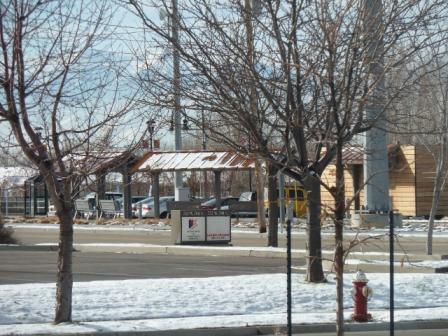 Bountiful/Woods Cross 5th S. PCE PlumeThe 450-acre Bountiful/Woods Cross 5th South PCE Plume Superfund site is in Bountiful, Utah. It includes two properties – the 50-acre Hatchco property and the 400-acre Bountiful Family Cleaners (BFC) property. From 1936 to 1996, several businesses operated on site, including a petroleum facility, a dry cleaner and a trucking business. Over time, spills and leaks from operations and holding tanks contaminated soil and groundwater. The main contaminant at the BFC property was tetrachloroethylene (PCE) and at the Hatchco property was trichloroethylene (TCE). PCE is a solvent used by dry cleaners in the cleaning process and TCE is used as a solvent to remove grease from metal parts. EPA added the site to the National Priorities List (NPL) in 2001. Cleanup included use of barriers, a water treatment system and long-term monitoring. Construction of the water treatment system finished in 2011. The site is currently in reuse. The Utah Transit Authority paved part of the Hatchco property to serve as a vehicle parking lot for the Utah Commuter Rail System. BFC remains active at the site and leases parts of its property to other commercial businesses. There are continued industrial, agricultural and residential land uses in the area impacted by groundwater contamination. Interstate 15 and rail lines also cross the site.
Bountiful/Woods Cross 5th S. PCE PlumeThe 450-acre Bountiful/Woods Cross 5th South PCE Plume Superfund site is in Bountiful, Utah. It includes two properties – the 50-acre Hatchco property and the 400-acre Bountiful Family Cleaners (BFC) property. From 1936 to 1996, several businesses operated on site, including a petroleum facility, a dry cleaner and a trucking business. Over time, spills and leaks from operations and holding tanks contaminated soil and groundwater. The main contaminant at the BFC property was tetrachloroethylene (PCE) and at the Hatchco property was trichloroethylene (TCE). PCE is a solvent used by dry cleaners in the cleaning process and TCE is used as a solvent to remove grease from metal parts. EPA added the site to the National Priorities List (NPL) in 2001. Cleanup included use of barriers, a water treatment system and long-term monitoring. Construction of the water treatment system finished in 2011. The site is currently in reuse. The Utah Transit Authority paved part of the Hatchco property to serve as a vehicle parking lot for the Utah Commuter Rail System. BFC remains active at the site and leases parts of its property to other commercial businesses. There are continued industrial, agricultural and residential land uses in the area impacted by groundwater contamination. Interstate 15 and rail lines also cross the site.
Last updated September 2019
As of December 2019, EPA had data on 4 on-site businesses. These businesses employed 39 people and generated an estimated $2,476,185 in annual sales revenue. For additional information click here.
For more information:
Davenport and Flagstaff Smelters 
The Davenport and Flagstaff Smelters Superfund site is located near Sandy, Utah, about 15 miles from Salt Lake City. The site is in a residential and commercial area at the mouth of Little Cottonwood Canyon. The Davenport, McKay and Flagstaff smelters operated throughout the 1800s. In 1991, the discovery of ladle casts in Little Cottonwood Creek near the Flagstaff Smelter prompted a study of smelter sites in the Salt Lake Valley. Investigations by EPA in 1992 and by the Utah Department of Environmental Quality (UDEQ) in 1994 found high levels of arsenic and lead in soil at both smelter locations. EPA added the site to the National Priorities List (NPL) in 2003. In 2006, under an agreement and with oversight by EPA and UDEQ, Little Cottonwood Canyon Partners, LLC cleaned up part of the site for residential redevelopment. In 2011, UDEQ led the cleanup of a commercial area where a restaurant was located and undeveloped land designated as a watershed protection zone. All of the cleanups included the removal and proper disposal of contaminated soils. The site is in continued use. Land uses include a residential area, a restaurant and the watershed protection zone. In 2018, EPA removed the site from the NPL.
Last updated September 2019
As of December 2019, EPA had data on 3 on-site businesses. These businesses employed 116 people and generated an estimated $4,223,000 in annual sales revenue. For additional information click here.
For more information:
Empire Canyon
The Empire Canyon site is located in the headwaters of Empire Canyon, south of Park City, Utah, about 25 miles from Salt Lake City. Beginning in the late 1800s, ore mining and processing facilities operated on site, contaminating a 36-acre area with mine wastes containing arsenic, lead and zinc. In 2000, a local watershed group found contaminated soils and surface water. In 2003, the site owner, United Park City Mines Company (UPCMC), agreed to clean up the site. Cleanup included removing contaminated soil, covering areas with clean soil and rerouting surface water. In 2006, EPA and the U.S. Department of Justice negotiated a Prospective Lessee Agreement (PLA) with UPCMC’s new lessee, DV Luxury Resort, LLC (DVLR). The PLA provided liability relief for DVLR in exchange for DVLR's help with cleanup. Since 2006, DVLR has constructed the Montage Deer Valley Resort & Spa. The luxury hotel features a spa, restaurants, event spaces, a condominium complex, and ski-in, ski-out access to Deer Valley Resort. With help from EPA, DVLR incorporated sustainable features into all phases of the resort’s creation, from design to construction. The resort opened in 2010. It participates in the U.S. Green Building Council’s Leadership in Energy and Environmental Design (LEED) program. DVLR used local building materials during construction and added a 2,800-acre conservation easement around the resort. The resort uses wind-generated power from Utah Blue Sky, has a comprehensive recycling system and provides local jobs.
Last updated September 2019
As of December 2019, EPA had data on one on-site business. This business employed 500 people and generated an estimated $26,000,000 in annual sales revenue. For additional information click here.
For more information:
Eureka Mills 
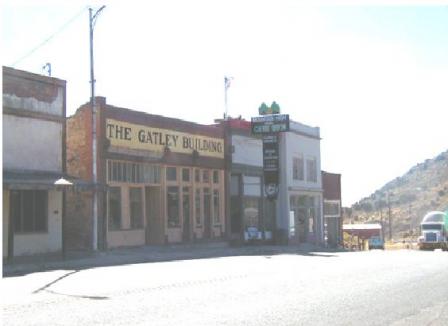 Eureka MillsThe Eureka Mills Superfund site is located about 80 miles from Salt Lake City, Utah. This historic mining area includes Eureka, a city of 800 residents, and some nearby areas. Mining activities started in 1870, after the discovery of silver, lead and minerals. Mining ended in 1958. EPA started cleanup actions in 2000 and 2001, after sampling confirmed high levels of contamination in the area. In 2002, EPA added the site to the National Priorities List (NPL). Between 2001 and 2010, EPA cleaned up more than 700 properties in Eureka. Other actions included waste capping, contaminated soil disposal, land use controls and public health actions. EPA completed cleanup activities a year ahead of schedule. Since site boundaries included the entire city, many properties in Eureka were already in residential and commercial use before the Superfund cleanup. EPA’s cleanup planning enabled continued commercial and residential use of the site during cleanup activities while also ensuring a safe living and working environment. The site also includes public services such as schools and government offices. In 2018, EPA deleted the site from the NPL.
Eureka MillsThe Eureka Mills Superfund site is located about 80 miles from Salt Lake City, Utah. This historic mining area includes Eureka, a city of 800 residents, and some nearby areas. Mining activities started in 1870, after the discovery of silver, lead and minerals. Mining ended in 1958. EPA started cleanup actions in 2000 and 2001, after sampling confirmed high levels of contamination in the area. In 2002, EPA added the site to the National Priorities List (NPL). Between 2001 and 2010, EPA cleaned up more than 700 properties in Eureka. Other actions included waste capping, contaminated soil disposal, land use controls and public health actions. EPA completed cleanup activities a year ahead of schedule. Since site boundaries included the entire city, many properties in Eureka were already in residential and commercial use before the Superfund cleanup. EPA’s cleanup planning enabled continued commercial and residential use of the site during cleanup activities while also ensuring a safe living and working environment. The site also includes public services such as schools and government offices. In 2018, EPA deleted the site from the NPL.
Last updated September 2019
As of December 2019, EPA had data on 22 on-site businesses. These businesses employed 160 people and generated an estimated $1,898,391 in annual sales revenue. For additional information click here.
For more information:
- Eureka Mills, Eureka, UT - Reuse Plan (PDF) (22 pp, 1.8 MB, About PDF)
- Superfund Site Profile Page
- Eureka: A Superfund Success Story
Five Points PCE Plume
The Five Points PCE Plume Superfund site is in the Salt Lake Valley in Davis County, Utah. An area of contaminated groundwater begins in the town of Bountiful and extends for about one mile under Woods Cross City and North Salt Lake City. Woods Cross City found tetrachloroethylene (PCE) contamination in a drinking water supply well in 1988. Investigations found that the most likely source of the PCE was Your Valet Cleaners, a dry cleaner facility in Bountiful. The business used PCE for dry cleaning from 1964 to 2002, when they switched to a silicone dry cleaning solution. EPA added the site to the National Priorities List (NPL) in 2007. Utah Department of Environmental Quality is leading ongoing investigation and cleanup efforts. EPA selected a remedy for the site in 2016. Cleanup includes groundwater pumping and treatment, as needed, and land and groundwater use restrictions to prevent contact with contamination. The site is located in an established urban area with continued residential and commercial uses.
Last updated September 2019
As of December 2019, EPA had data on one on-site business. This business employed 2 people and generated an estimated $35,000 in annual sales revenue. For additional information click here.
For more information:
Intermountain Waste Oil Refinery 

The 2-acre Intermountain Waste Oil Refinery Superfund site is located in Bountiful, Utah. Beginning in 1957, operators used the area for waste oil handling, refining, blending and shipping. The Davis County Health Department and the Utah Department of Environmental Quality (UDEQ) cited the business several times because nearby residents complained of odors and health issues. After the company closed in 1993, UDEQ investigated the extent of contamination in soil and groundwater. Human health risks led EPA to add the site to the National Priorities List (NPL) in 2000. EPA removed chemical containers, storage barrels, scrap equipment, debris and underground tanks. In 2006, Bountiful Irrigation purchased the site property. The irrigation supply and design business built an office and garage, and fenced the property. The office uses a vapor mitigation system, which EPA required because contaminated groundwater extends below parts of the building. Groundwater monitoring at the site is ongoing.
Last updated September 2019
As of December 2019, EPA had data on one on-site business. This business employed 9 people and generated an estimated $1,100,000 in annual sales revenue. For additional information click here.
For more information:
International Smelting and Refining 

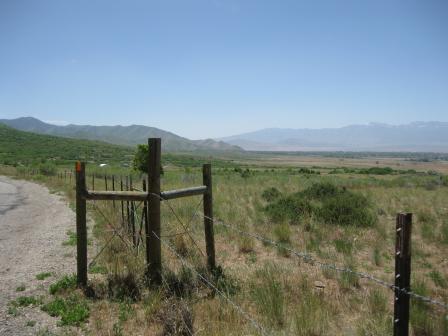 International Smelting and RefiningThe 1,200-acre International Smelting and Refining Superfund site is located northeast of Tooele, Utah. The site is near the mouth of Pine Canyon, which drains into Pine Creek. Between 1910 and 1972, the Atlantic Richfield Company (now known as ARCO) operated copper smelters that also recovered lead and zinc. Smelter operations produced about 650,000 tons of smelter waste and dust. Wind spread contaminants and dust from tailings piles over large areas of surface soils. In response to elevated blood-lead levels of area residents, EPA placed the site on the National Priorities List (NPL) in 2000. With EPA oversight, ARCO conducted targeted cleanups at the smelter facility, the Tooele Valley Railroad and the Pine Canyon community. Immediate cleanup actions removed contaminated soils from some residential properties closest to the former smelter area. Cleanup along the former Tooele Valley Railroad, the Pine Canyon Conservation Area and city-owned Oquirrh Hills Golf Course included removal of contaminated soil, backfilling with clean soil, capping of areas where contaminated soil was not removed and revegetation using native plants. Actions to ensure the remedy’s long-term stability included fencing, stormwater control modification and repair, and land use controls. EPA took the site off the NPL in 2011. As a result of Superfund cleanup, the site remains in use. The Utah Division of Wildlife Resources manages the former smelter area as the Pine Canyon Conservation Area. This area provides the public with recreation opportunities, including hiking, horseback riding, wildlife observation and hunting. Part of the Tooele Valley Railroad cleanup area included the city-owned Oquirrh Hills Golf Course, which remains in operation today. The former Toole Valley rail line is now a biking and walking trail. Cleanup has also allowed for continued use of residential properties. A gun club with a trapshooting club also operates on site.
International Smelting and RefiningThe 1,200-acre International Smelting and Refining Superfund site is located northeast of Tooele, Utah. The site is near the mouth of Pine Canyon, which drains into Pine Creek. Between 1910 and 1972, the Atlantic Richfield Company (now known as ARCO) operated copper smelters that also recovered lead and zinc. Smelter operations produced about 650,000 tons of smelter waste and dust. Wind spread contaminants and dust from tailings piles over large areas of surface soils. In response to elevated blood-lead levels of area residents, EPA placed the site on the National Priorities List (NPL) in 2000. With EPA oversight, ARCO conducted targeted cleanups at the smelter facility, the Tooele Valley Railroad and the Pine Canyon community. Immediate cleanup actions removed contaminated soils from some residential properties closest to the former smelter area. Cleanup along the former Tooele Valley Railroad, the Pine Canyon Conservation Area and city-owned Oquirrh Hills Golf Course included removal of contaminated soil, backfilling with clean soil, capping of areas where contaminated soil was not removed and revegetation using native plants. Actions to ensure the remedy’s long-term stability included fencing, stormwater control modification and repair, and land use controls. EPA took the site off the NPL in 2011. As a result of Superfund cleanup, the site remains in use. The Utah Division of Wildlife Resources manages the former smelter area as the Pine Canyon Conservation Area. This area provides the public with recreation opportunities, including hiking, horseback riding, wildlife observation and hunting. Part of the Tooele Valley Railroad cleanup area included the city-owned Oquirrh Hills Golf Course, which remains in operation today. The former Toole Valley rail line is now a biking and walking trail. Cleanup has also allowed for continued use of residential properties. A gun club with a trapshooting club also operates on site.
Last updated September 2019
As of December 2019, EPA had data on 4 on-site businesses. These businesses employed 12 people and generated an estimated $110,000 in annual sales revenue. For additional information click here.
For more information:
Jacobs Smelter 
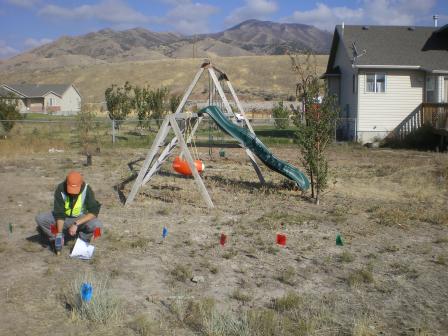 Jacobs SmelterThe Jacobs Smelter Superfund site includes the town of Stockton, Utah, and surrounding areas. Reports documented at least nine smelters with milling operations at the site during the 1800s. The site’s name comes from one of the largest smelting operations in the area. These smelter operations caused soil contamination. EPA discovered contamination at the site in 1995. In 1999, EPA began cleaning up the former Jacobs Smelter property and 29 heavily-contaminated residential properties. EPA added the site to the National Priorities List (NPL) in 2000. EPA divided the site into six operable units (OUs). Cleanups have been completed in the town of Stockton (OU1), an area owned by Union Pacific Railroad (OU3), and an area owned by Rio Tinto Kennecott (OU4). EPA deleted OU1 and OU3 from the NPL in 2001 and 2005, respectively. Cleanup is continuing at OU2. EPA is assessing whether cleanup at OU5 is complete. A remedial investigation and feasibility study are needed at OU6 before EPA can select a cleanup plan. OU4 will be proposed for partial deletion in the near future, and as OU2, OU5 and OU6 reach cleanup goals, EPA will remove them from the NPL. Continued uses at the site include the town of Stockton, an active rail line, and residential, recreational and commercial areas.
Jacobs SmelterThe Jacobs Smelter Superfund site includes the town of Stockton, Utah, and surrounding areas. Reports documented at least nine smelters with milling operations at the site during the 1800s. The site’s name comes from one of the largest smelting operations in the area. These smelter operations caused soil contamination. EPA discovered contamination at the site in 1995. In 1999, EPA began cleaning up the former Jacobs Smelter property and 29 heavily-contaminated residential properties. EPA added the site to the National Priorities List (NPL) in 2000. EPA divided the site into six operable units (OUs). Cleanups have been completed in the town of Stockton (OU1), an area owned by Union Pacific Railroad (OU3), and an area owned by Rio Tinto Kennecott (OU4). EPA deleted OU1 and OU3 from the NPL in 2001 and 2005, respectively. Cleanup is continuing at OU2. EPA is assessing whether cleanup at OU5 is complete. A remedial investigation and feasibility study are needed at OU6 before EPA can select a cleanup plan. OU4 will be proposed for partial deletion in the near future, and as OU2, OU5 and OU6 reach cleanup goals, EPA will remove them from the NPL. Continued uses at the site include the town of Stockton, an active rail line, and residential, recreational and commercial areas.
Last updated September 2019
As of December 2019, EPA had data on 9 on-site businesses. These businesses employed 27 people and generated an estimated $1,219,565 in annual sales revenue. For additional information click here.
For more information:
Kennecott (North Zone) 
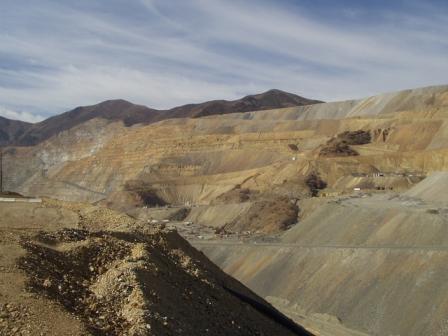 Kennecott (North Zone)The Kennecott (North Zone) site is located in an industrial area west of Salt Lake City, Utah. Starting in 1906, the Kennecott Utah Copper Company (Kennecott) processed metals, including copper and lead, in the area. Production wastes contaminated area soil and groundwater. This contamination forced the closure of drinking water wells in the area. EPA proposed listing the site on the National Priorities List (NPL) in January 1994. In 1995, EPA agreed that Kennecott would continue the cleanup and EPA would postpone the site’s listing on the NPL. Kennecott’s cleanup included removal and disposal of contaminated soils, sediments and sludges. Kennecott is currently cleaning up groundwater and has connected residences and businesses to public water supply lines. Today, Kennecott maintains active mining operations on part of the site. Interstate 80, state highways and rail lines pass through the site. The entire community of Magna is considered a part of the site, including continued residential, commercial and public service uses. Part of the site bordering the Great Salt Lake provides recreation and research opportunities. Kennecott purchased land along the south shore of the Great Salt Lake and turned a once-degraded wetland into a shorebird and waterfowl reserve. Birding groups, schools and university research teams observe and study wildlife in the wetland, which has become a haven for birds and an important education and scientific resource.
Kennecott (North Zone)The Kennecott (North Zone) site is located in an industrial area west of Salt Lake City, Utah. Starting in 1906, the Kennecott Utah Copper Company (Kennecott) processed metals, including copper and lead, in the area. Production wastes contaminated area soil and groundwater. This contamination forced the closure of drinking water wells in the area. EPA proposed listing the site on the National Priorities List (NPL) in January 1994. In 1995, EPA agreed that Kennecott would continue the cleanup and EPA would postpone the site’s listing on the NPL. Kennecott’s cleanup included removal and disposal of contaminated soils, sediments and sludges. Kennecott is currently cleaning up groundwater and has connected residences and businesses to public water supply lines. Today, Kennecott maintains active mining operations on part of the site. Interstate 80, state highways and rail lines pass through the site. The entire community of Magna is considered a part of the site, including continued residential, commercial and public service uses. Part of the site bordering the Great Salt Lake provides recreation and research opportunities. Kennecott purchased land along the south shore of the Great Salt Lake and turned a once-degraded wetland into a shorebird and waterfowl reserve. Birding groups, schools and university research teams observe and study wildlife in the wetland, which has become a haven for birds and an important education and scientific resource.
Last updated September 2019
As of December 2019, EPA had data on 198 on-site businesses. These businesses employed 2,944 people and generated an estimated $235,194,944 in annual sales revenue. For additional information click here.
For more information:
Kennecott (South Zone) 
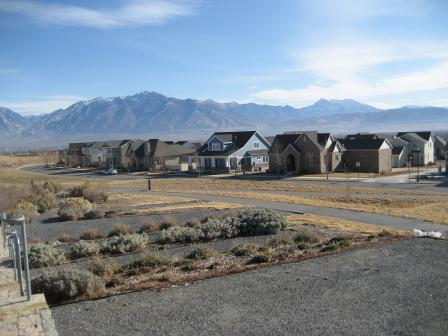 Kennecott (South Zone)The Kennecott (South Zone) site is located southwest of Salt Lake City, Utah. It covers about 37 square miles. Mining activities at the site began in the 1860s and continue today. Starting in 1906, the Kennecott Utah Copper Company (Kennecott) also used the area to process metals. Wastes produced by these activities contaminated soil, groundwater, surface water and sediment. This contamination led to the closure of drinking water wells in the area. EPA proposed listing the site on the National Priorities List (NPL) in 1994. In 1999, Kennecott removed more than 25 million tons of contamination. EPA withdrew the site’s NPL listing proposal in 2008, after signing a cleanup agreement with Kennecott. Cleanup included removal of contaminated soils, sediments and sludges. Groundwater treatment is ongoing. Cleanup has also resulted in significant ecological benefits, including the creation of about 1,000 acres of wildlife habitat and open space. The Kennecott Land Company redeveloped 4,126 acres of the site into the Daybreak community. The development is a model of environmentally and socially responsible growth. All 13,600 homes and 9.1 million square feet of commercial building space meet EPA Energy Star efficiency guidelines. The community also features 1,250 acres of parks, a recreational lake, pedestrian-friendly town centers, shops, restaurants, grocery stores, churches, schools and mass transit. Kennecott’s owner, Rio Tinto, opened a corporate office in the Daybreak community. The office has been certified by the U.S. Green Building Council’s Leadership in Energy and Environmental Design program. Ongoing development in the Daybreak community includes public transportation corridors, additional homes and businesses, as well as light industry and agriculture.
Kennecott (South Zone)The Kennecott (South Zone) site is located southwest of Salt Lake City, Utah. It covers about 37 square miles. Mining activities at the site began in the 1860s and continue today. Starting in 1906, the Kennecott Utah Copper Company (Kennecott) also used the area to process metals. Wastes produced by these activities contaminated soil, groundwater, surface water and sediment. This contamination led to the closure of drinking water wells in the area. EPA proposed listing the site on the National Priorities List (NPL) in 1994. In 1999, Kennecott removed more than 25 million tons of contamination. EPA withdrew the site’s NPL listing proposal in 2008, after signing a cleanup agreement with Kennecott. Cleanup included removal of contaminated soils, sediments and sludges. Groundwater treatment is ongoing. Cleanup has also resulted in significant ecological benefits, including the creation of about 1,000 acres of wildlife habitat and open space. The Kennecott Land Company redeveloped 4,126 acres of the site into the Daybreak community. The development is a model of environmentally and socially responsible growth. All 13,600 homes and 9.1 million square feet of commercial building space meet EPA Energy Star efficiency guidelines. The community also features 1,250 acres of parks, a recreational lake, pedestrian-friendly town centers, shops, restaurants, grocery stores, churches, schools and mass transit. Kennecott’s owner, Rio Tinto, opened a corporate office in the Daybreak community. The office has been certified by the U.S. Green Building Council’s Leadership in Energy and Environmental Design program. Ongoing development in the Daybreak community includes public transportation corridors, additional homes and businesses, as well as light industry and agriculture.
Last updated September 2019
As of December 2019, EPA had data on 158 on-site businesses. These businesses employed 4,528 people and generated an estimated $2,322,362,193 in annual sales revenue. For additional information click here.
For more information:
- Reuse and the Benefit to Community: Kennecott South Zone Superfund Site (PDF)(27 pp, 4.8 MB)
- Superfund Site Profile Page
Midvale Slag 

 Midvale SlagThe 446-acre Midvale Slag Superfund site is in Midvale City, Utah. From 1871 to 1958, five smelters processed lead and copper ore at the site. Site operations resulted in toxic levels of heavy metals in area soils and groundwater. EPA added the site to the National Priorities List (NPL) in 1991. EPA worked with state agencies, the city of Midvale (the City), local citizens and the site owner to link the cleanup with revitalization and redevelopment goals. Midvale became the first community in EPA Region 8 selected as a Superfund Redevelopment pilot project. This led to the groundbreaking creation of the Bingham Junction Reuse Assessment and Master Plan in 2000. Today, the site is home to Bingham Junction, a thriving mixed-use development supporting thousands of jobs. Builders have completed extensive residential development at the site. New buildings on site include single-family homes, townhomes, condominiums, apartments and assisted living. The site is also home to office buildings, a supermarket and other stores. FL Smidth, an international engineering company, operates office and laboratory buildings on site. Its buildings achieved the U.S. Green Building Council’s Leadership in Energy and Environmental Design program’s Gold and Silver certifications. CHG Healthcare Services developed 283,000 square feet of space. Overstock.com developed a 231,000-square-foot office building, a 50,000-square-foot daycare and fitness studio, parking structure, and greenhouse to provide fresh fruits and vegetables for the on-site café. In total, developers plan to build up to 2 million square feet of commercial office and retail space on site. EPA also addressed soil contamination in an unmarked pioneer cemetery on the site. Sections of Bingham Junction’s Riverwalk Park have opened, providing improved community access to the Jordan River. A Utah Transit Authority light rail station opened on site in summer 2011. In 2015, EPA took the site off the NPL; all required cleanup activity is complete. EPA Region 8 also recognized the City with an Excellence in Site Reuse Award for their efforts to support reuse and redevelopment at the site. The Midvale Redevelopment Agency reopened Bingham Junction Park in 2016 with a new softball field, basketball court, play structure and sledding hill. Twenty-plus years of collaboration and dedication at the local, state and federal level have transformed this once-contaminated land into a vibrant community resource.
Midvale SlagThe 446-acre Midvale Slag Superfund site is in Midvale City, Utah. From 1871 to 1958, five smelters processed lead and copper ore at the site. Site operations resulted in toxic levels of heavy metals in area soils and groundwater. EPA added the site to the National Priorities List (NPL) in 1991. EPA worked with state agencies, the city of Midvale (the City), local citizens and the site owner to link the cleanup with revitalization and redevelopment goals. Midvale became the first community in EPA Region 8 selected as a Superfund Redevelopment pilot project. This led to the groundbreaking creation of the Bingham Junction Reuse Assessment and Master Plan in 2000. Today, the site is home to Bingham Junction, a thriving mixed-use development supporting thousands of jobs. Builders have completed extensive residential development at the site. New buildings on site include single-family homes, townhomes, condominiums, apartments and assisted living. The site is also home to office buildings, a supermarket and other stores. FL Smidth, an international engineering company, operates office and laboratory buildings on site. Its buildings achieved the U.S. Green Building Council’s Leadership in Energy and Environmental Design program’s Gold and Silver certifications. CHG Healthcare Services developed 283,000 square feet of space. Overstock.com developed a 231,000-square-foot office building, a 50,000-square-foot daycare and fitness studio, parking structure, and greenhouse to provide fresh fruits and vegetables for the on-site café. In total, developers plan to build up to 2 million square feet of commercial office and retail space on site. EPA also addressed soil contamination in an unmarked pioneer cemetery on the site. Sections of Bingham Junction’s Riverwalk Park have opened, providing improved community access to the Jordan River. A Utah Transit Authority light rail station opened on site in summer 2011. In 2015, EPA took the site off the NPL; all required cleanup activity is complete. EPA Region 8 also recognized the City with an Excellence in Site Reuse Award for their efforts to support reuse and redevelopment at the site. The Midvale Redevelopment Agency reopened Bingham Junction Park in 2016 with a new softball field, basketball court, play structure and sledding hill. Twenty-plus years of collaboration and dedication at the local, state and federal level have transformed this once-contaminated land into a vibrant community resource.
Last updated September 2019
As of December 2019, EPA had data on 58 on-site businesses. These businesses employed 3,469 people and generated an estimated $1,734,167,029 in annual sales revenue. For additional information click here.
For more information:
- Midvale Slag Ready for Reuse Determination (2008) (PDF) (103 pp, 10.1 MB, About PDF)
- Cleanup and Mixed-Use Revitalization on the Wasatch Front: The Midvale Slag Superfund Site and Midvale City, Utah (PDF) (18 pp, 1.9 MB)
- Midvale Slag Reuse Case Study (PDF) (7 pp, 1.3 MB)
- Redevelopment of the Midvale Slag Superfund Site (PDF)(1 pg, 64 K)
- Reuse and the Benefit to Community: Midvale Slag (PDF)(38 pp, 3.1 MB)
- Superfund Site Profile Page
-
Video: From Midvale Slag to Bingham Junction
Murray Smelter 


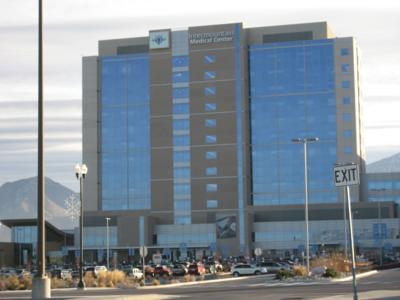 Murray SmelterThe 142-acre Murray Smelter Superfund site is in Murray City, Utah. This former mineral-processing site was once the largest lead smelter in the country. Site testing found contaminated soil, surface water, groundwater and sediment. EPA Region 8 and Murray City (the City) entered into a unique agreement establishing a formal role for the City in planning the site’s cleanup and future use. EPA and the City coordinated the site’s cleanup and redevelopment plans. The City brought together site property owners and the potentially responsible party, ASARCO, to discuss the site’s redevelopment. The parties committed to building cleanup structures and following the Murray City General Land Use Plan. Based on outcomes from these discussions, EPA chose a cleanup plan that incorporated the site’s anticipated future use. Today, the site is home to a Utah Transit Authority light rail station with a 300-space parking lot and a designated connector road. The Intermountain Medical Center, a 1.5-million-square-foot, $362.5-million hospital facility, began operating on site in 2007. Several commercial and industrial businesses, as well as a police training facility, also operate on site. Site redevelopment awards include a 2006 Phoenix Award and a 2014 State Excellence in Supporting Reuse Award. EPA Region 8 and Murray City continue to work together to promote the safe and beneficial reuse of the site.
Murray SmelterThe 142-acre Murray Smelter Superfund site is in Murray City, Utah. This former mineral-processing site was once the largest lead smelter in the country. Site testing found contaminated soil, surface water, groundwater and sediment. EPA Region 8 and Murray City (the City) entered into a unique agreement establishing a formal role for the City in planning the site’s cleanup and future use. EPA and the City coordinated the site’s cleanup and redevelopment plans. The City brought together site property owners and the potentially responsible party, ASARCO, to discuss the site’s redevelopment. The parties committed to building cleanup structures and following the Murray City General Land Use Plan. Based on outcomes from these discussions, EPA chose a cleanup plan that incorporated the site’s anticipated future use. Today, the site is home to a Utah Transit Authority light rail station with a 300-space parking lot and a designated connector road. The Intermountain Medical Center, a 1.5-million-square-foot, $362.5-million hospital facility, began operating on site in 2007. Several commercial and industrial businesses, as well as a police training facility, also operate on site. Site redevelopment awards include a 2006 Phoenix Award and a 2014 State Excellence in Supporting Reuse Award. EPA Region 8 and Murray City continue to work together to promote the safe and beneficial reuse of the site.
Last updated September 2019
As of December 2019, EPA had data on 11 on-site businesses. These businesses employed 6,234 people and generated an estimated $1,324,281,923 in annual sales revenue. For additional information click here.
For more information:
- Reuse and the Benefit to Community: Murray Smelter Superfund Site (PDF) (10 pp, 1.0 MB, About PDF)
- Redevelopment of the Murray Smelter Superfund Site (PDF)(1 pg, 106 K)
- Superfund Site Profile Page
Ogden Railroad Yard 


 Ogden Railroad YardThe Ogden Railroad Yard site is located on the west side of Ogden, Utah, about 40 miles north of Salt Lake City. The site includes 1,120 acres bounded by the Weber River, the Ogden River and Goode Lake. For almost 150 years, the area has been the location of railway operations. Spills and improper handling of hazardous substances resulted in contaminated groundwater, sediment, soil and sludge. EPA began cleanup efforts in 1994. Activities included soil removal, capping and land use restrictions. EPA oversees ongoing groundwater monitoring as well as maintenance of the Goode Lake coffer dam, fencing and land use restrictions. While cleanup was underway, the Utah Transit Authority (UTA) built the FrontRunner commuter rail line, which extends across the site, providing service from Pleasant View to Salt Lake City. UTA also constructed a flyover bridge and a passenger station at the site. A rail car maintenance and scrap metal facility also operates on site. EPA worked with the community to integrate local reuse priorities into site cleanup plans. Goode Lake, which closed during part of the cleanup, now hosts fishing and a water-skiing area. Historic Union Station, built on site in 1924, is now home to museums, an art gallery, shops and a visitor center. In 2006, the site earned the prestigious Phoenix Award for achievement of excellence in Superfund site reuse.
Ogden Railroad YardThe Ogden Railroad Yard site is located on the west side of Ogden, Utah, about 40 miles north of Salt Lake City. The site includes 1,120 acres bounded by the Weber River, the Ogden River and Goode Lake. For almost 150 years, the area has been the location of railway operations. Spills and improper handling of hazardous substances resulted in contaminated groundwater, sediment, soil and sludge. EPA began cleanup efforts in 1994. Activities included soil removal, capping and land use restrictions. EPA oversees ongoing groundwater monitoring as well as maintenance of the Goode Lake coffer dam, fencing and land use restrictions. While cleanup was underway, the Utah Transit Authority (UTA) built the FrontRunner commuter rail line, which extends across the site, providing service from Pleasant View to Salt Lake City. UTA also constructed a flyover bridge and a passenger station at the site. A rail car maintenance and scrap metal facility also operates on site. EPA worked with the community to integrate local reuse priorities into site cleanup plans. Goode Lake, which closed during part of the cleanup, now hosts fishing and a water-skiing area. Historic Union Station, built on site in 1924, is now home to museums, an art gallery, shops and a visitor center. In 2006, the site earned the prestigious Phoenix Award for achievement of excellence in Superfund site reuse.
Last updated September 2019
As of December 2019, EPA had data on 7 on-site businesses. These businesses employed 53 people and generated an estimated $5,492,000 in annual sales revenue. For additional information click here.
For more information:
Pallas Yard 
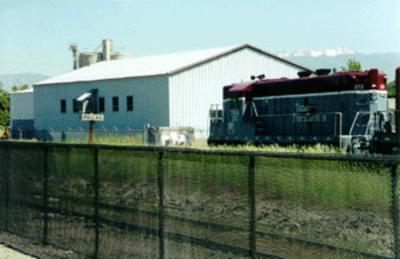 Pallas YardThe Pallas Yard site is in Murray City, Utah. The site is an active rail yard that includes five sets of tracks. Union Pacific and the Denver & Rio Grande railroads laid the original Pallas Yard rail lines around the turn of the 20th century to support a growing smelter industry. During rail yard development, construction workers used materials containing arsenic and lead. The arsenic contaminated groundwater. The Utah Transit Authority (UTA) purchased the site property in 1995 as part of the TRAX Light Rail Transportation Project in preparation for the 2002 Winter Olympics. UTA, in partnership with EPA and the state, cleaned up the site. Cleanup activities included soil removal and placement in sound-muffling berms along the railroad tracks. Since cleanup, UTA uses the site as a thoroughfare for TRAX. A flyover bridge extending 300 West over 5300 South has been in use since 2007. Groundwater monitoring is ongoing.
Pallas YardThe Pallas Yard site is in Murray City, Utah. The site is an active rail yard that includes five sets of tracks. Union Pacific and the Denver & Rio Grande railroads laid the original Pallas Yard rail lines around the turn of the 20th century to support a growing smelter industry. During rail yard development, construction workers used materials containing arsenic and lead. The arsenic contaminated groundwater. The Utah Transit Authority (UTA) purchased the site property in 1995 as part of the TRAX Light Rail Transportation Project in preparation for the 2002 Winter Olympics. UTA, in partnership with EPA and the state, cleaned up the site. Cleanup activities included soil removal and placement in sound-muffling berms along the railroad tracks. Since cleanup, UTA uses the site as a thoroughfare for TRAX. A flyover bridge extending 300 West over 5300 South has been in use since 2007. Groundwater monitoring is ongoing.
Last updated September 2019
As of December 2019, EPA did not have economic data related to on-site businesses, or economic data were not applicable due to site use. For additional information click here.
For more information:
Petrochem Recycling Corp./Ekotek Plant
The 7-acre Petrochem Recycling Corp./Ekotek Plant Superfund site is in northern Salt Lake City, Utah. From 1953 through 1988, a used oil refinery and oil reclaiming/recycling facility operated at the site. Improper and illegal waste management practices led to contamination of groundwater and soil. EPA added the site to the National Priorities List (NPL) in 1992. Cleanup included removal of contaminated soil and liquid wastes for disposal off site and using natural processes to address groundwater contamination. EPA removed the site from the NPL in 2003. Groundwater monitoring is ongoing. The site owner uses the southeast portion of the site to store delivery trucks, garbage trucks and truck parts. The northwest side of the site is leased to a company that crushes concrete/rock and stages gravel and soil.
Last updated September 2019
As of December 2019, EPA had data on 2 on-site businesses. EPA did not have further economic details related to these businesses. For additional information click here.
For more information:
Portland Cement (Kiln Dust 2 & 3)
The 71-acre Portland Cement (Kiln Dust 2 & 3) Superfund site is in Salt Lake City, Utah. The Portland Cement Plant deposited about 55,000 cubic yards of cement kiln dust (CKD) as fill material at the site between 1963 and 1983. CKD and other waste materials deposited at the site contain high concentrations of heavy metals. Disposal practices contaminated soil, air and groundwater with heavy metals. EPA added the site to the National Priorities List (NPL) in 1986. Cleanup included the removal, treatment and off-site disposal of contaminated waste. Groundwater monitoring continues at the site. Land use easements allow EPA and the state access for inspections and sampling. The easements also state restrictions on land and groundwater use at the site. Site redevelopment includes a charter school, warehouses, an indoor soccer stadium, roadways and a high-capacity underground sanitary sewer system. A new industrial park, the Redwood Depot Industrial Park, is viable and construction is nearing completion. Tenants of the industrial park include a trucking company, truck parts supplier, and a wholesale equipment company.
Last updated September 2019
As of December 2019, EPA had data on 14 on-site businesses. These businesses employed 153 people and generated an estimated $18,977,000 in annual sales revenue. For additional information click here.
For more information:
- Reuse and the Benefit to Community: A Beneficial Effects Economic Case Study for the Portland Cement (Kiln Dust 2 & 3) Superfund Site (PDF)(12 pp, 1.7 MB)
- Superfund Site Profile Page
Richardson Flat Tailings
The 2,341-acre Richardson Flat Tailings site is located near Park City, Utah. Mining activities began in the mining district upgradient from the site in the late 1800s. The site is located in and around Silver Creek, which has been contaminated by tailings and waste rock from historic mining processing operations. EPA is currently working with Utah Department of Environmental Quality and Natural Resource Damage Trustees to investigate and evaluate cleanup options. During the ongoing investigation, there remains a high level of continued recreational and agricultural use at the site. A state park, the Historic Union Pacific Rail Trail, crosses the site and has a high frequency of ongoing recreational use at portions near Park City. A former tailings impoundment at the site has previously been partially remediated by a potentially responsible party who consolidated and stabilized tailings, as well as completed wetland restoration work. Native plants and animals have returned to use the areas of the impoundment addressed by the cleanup and restoration. Other areas of the impoundment will need additional cap material placed once site cleanup is fully complete.
Last updated September 2019
As of December 2019, EPA did not have economic data related to on-site businesses, or economic data were not applicable due to site use. For additional information click here.
For more information:
Rose Park Sludge Pit 
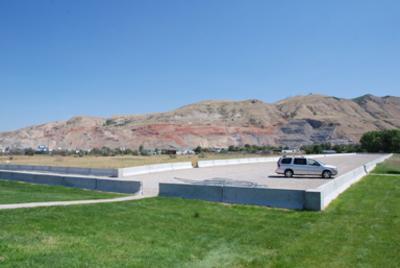 Rose Park Sludge PitThe 5-acre Rose Park Sludge Pit Superfund site is in Salt Lake City, Utah. Utah Oil and Refining Company disposed of contaminated waste in a pit on site from the 1930s until 1957. Salt Lake City (the City) purchased the property in 1957 and discovered the waste pit in 1976. EPA added the site to the National Priorities List (NPL) in 1983. Cleanup included the construction of a perimeter wall and capping of waste material. After cleanup, EPA took the site off the NPL in 2003. The City saw the area as an expansion opportunity for Rosewood Park, a popular community recreation facility next to the site. EPA worked with the state, the City and the responsible party on the project. The effort included additional parking areas and an informal dog park, which was the first area in the neighborhood where dogs could play unleashed. The City also built a playground and installed exercise equipment, sidewalks and new landscaping. The City also turned a property next to the site into a skate park. The park expansion has provided several community amenities while improving cleanup protectiveness by prohibiting motor vehicle access on the site’s capped area.
Rose Park Sludge PitThe 5-acre Rose Park Sludge Pit Superfund site is in Salt Lake City, Utah. Utah Oil and Refining Company disposed of contaminated waste in a pit on site from the 1930s until 1957. Salt Lake City (the City) purchased the property in 1957 and discovered the waste pit in 1976. EPA added the site to the National Priorities List (NPL) in 1983. Cleanup included the construction of a perimeter wall and capping of waste material. After cleanup, EPA took the site off the NPL in 2003. The City saw the area as an expansion opportunity for Rosewood Park, a popular community recreation facility next to the site. EPA worked with the state, the City and the responsible party on the project. The effort included additional parking areas and an informal dog park, which was the first area in the neighborhood where dogs could play unleashed. The City also built a playground and installed exercise equipment, sidewalks and new landscaping. The City also turned a property next to the site into a skate park. The park expansion has provided several community amenities while improving cleanup protectiveness by prohibiting motor vehicle access on the site’s capped area.
Last updated September 2019
As of December 2019, EPA did not have economic data related to on-site businesses, or economic data were not applicable due to site use. For additional information click here.
For more information:
Sharon Steel Corp. (Midvale Tailings) 

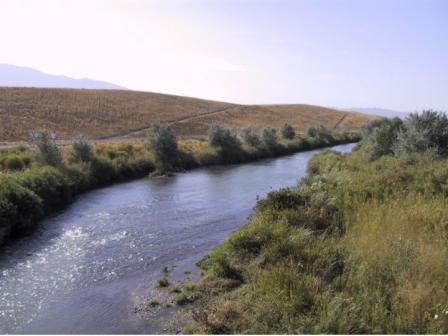 Sharon Steel Corp. (Midvale Tailings)The 470-acre Sharon Steel Corp. (Midvale Tailings) Superfund site is in Midvale, Utah. A smelting and ore-milling facility produced lead, copper, zinc and other metals on site from 1906 to 1971. Site investigations found contaminated groundwater and soil. EPA added the site to the National Priorities List (NPL) in 1990. EPA and the state of Utah’s cleanup activities included fence installation, riverbank stabilization, dust control, building removal, waste capping, groundwater monitoring, and removal of contaminated soil with clean soil backfilling. Soil cleanup allowed for the continued residential and commercial use of several impacted properties. Cleanup finished in 1999. EPA took the site off the NPL in 2004. The same year, EPA issued a Ready for Reuse Determination stating that the site is ready for residential and mixed reuse. The Jordan River Parkway Trail runs along the site’s western edge, supporting a variety of non-motorized recreational uses. In 2010, EPA developed a review document to help clarify what types of uses would be appropriate in the capped portion of the site. An extension of Bingham Junction Boulevard crosses the vacant portion of the site. In 2017, KC Gardner, the developer of the adjacent Midvale Slag Superfund site, purchased the undeveloped area of the site. The developer is planning a residential and commercial redevelopment project for the site called Jordan Bluffs. With EPA’s mission to protect human health and the environment in mind, EPA established the Superfund Task Force in May 2017 to provide recommendations for improving and expediting site cleanups and promoting redevelopment. Based on the Superfund Task Force recommendations, EPA identified the site as a Redevelopment Opportunity site – a site with the greatest expected redevelopment potential. In October 2018, the city of Midvale held a very successful redevelopment groundbreaking event for the Jordan Bluffs subdivision, a 265-acre, master-planned, mixed-use development that will include up to 1,000,000 square feet of office, data center, retail/hospitality, and residential components around a linear park.
Sharon Steel Corp. (Midvale Tailings)The 470-acre Sharon Steel Corp. (Midvale Tailings) Superfund site is in Midvale, Utah. A smelting and ore-milling facility produced lead, copper, zinc and other metals on site from 1906 to 1971. Site investigations found contaminated groundwater and soil. EPA added the site to the National Priorities List (NPL) in 1990. EPA and the state of Utah’s cleanup activities included fence installation, riverbank stabilization, dust control, building removal, waste capping, groundwater monitoring, and removal of contaminated soil with clean soil backfilling. Soil cleanup allowed for the continued residential and commercial use of several impacted properties. Cleanup finished in 1999. EPA took the site off the NPL in 2004. The same year, EPA issued a Ready for Reuse Determination stating that the site is ready for residential and mixed reuse. The Jordan River Parkway Trail runs along the site’s western edge, supporting a variety of non-motorized recreational uses. In 2010, EPA developed a review document to help clarify what types of uses would be appropriate in the capped portion of the site. An extension of Bingham Junction Boulevard crosses the vacant portion of the site. In 2017, KC Gardner, the developer of the adjacent Midvale Slag Superfund site, purchased the undeveloped area of the site. The developer is planning a residential and commercial redevelopment project for the site called Jordan Bluffs. With EPA’s mission to protect human health and the environment in mind, EPA established the Superfund Task Force in May 2017 to provide recommendations for improving and expediting site cleanups and promoting redevelopment. Based on the Superfund Task Force recommendations, EPA identified the site as a Redevelopment Opportunity site – a site with the greatest expected redevelopment potential. In October 2018, the city of Midvale held a very successful redevelopment groundbreaking event for the Jordan Bluffs subdivision, a 265-acre, master-planned, mixed-use development that will include up to 1,000,000 square feet of office, data center, retail/hospitality, and residential components around a linear park.
Last updated September 2019
As of December 2019, EPA did not have economic data related to on-site businesses, or economic data were not applicable due to site use. For additional information click here.
For more information:
US Magnesium
The 4,525-acre US Magnesium Superfund site is located next to the Great Salt Lake in Tooele County, Utah. In 1972, US Magnesium began magnesium production at the site. The process produced acidic waste that contaminated soil and groundwater. In addition to threatening the health of US Magnesium workers, the contamination posed a threat to birds and other wildlife. EPA added the site to the National Priorities List (NPL) in 2009. EPA met with interested stakeholders to support formation of a community advisory group to offer resources to area communities. While state and federal agencies determine the best cleanup plan for the site, US Magnesium still actively operates on the property. US Magnesium is the only remaining magnesium producer in the United States.
Last updated September 2019
As of December 2019, EPA had data on one on-site business. This business employed 350 people and generated an estimated $2,798,000 in annual sales revenue. For additional information click here.
For more information:
Utah Power & Light/American Barrel Co. 
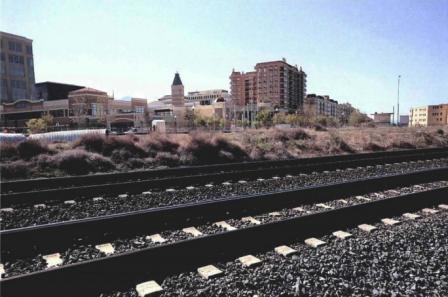 Utah Power & Light/American Barrel Co.The 2-acre Utah Power & Light/American Barrel Co. Superfund site is located in Salt Lake City, Utah. Site operators conducted barrel storage, wood-treating and coal gasification operations on site from 1870 to 1987. These operations produced byproducts such as tar, sludge, ash and liquid wastes. Combined with chemicals from leaking barrels, the byproducts contaminated soil and groundwater. EPA placed the site on the National Priorities List (NPL) in 1989. Utah Power & Light, the responsible party, removed 50,000 barrels, removed and disposed of contaminated soil off site, and built a soil vapor and groundwater extraction system. Remedy construction finished in 1996. The soil vapor and groundwater extraction system continues to operate. Groundwater monitoring is ongoing. Groundwater and land use restrictions are in place at the site. Several redevelopment activities have taken place at the site and nearby. In 2007, Union Pacific Railroad realigned tracks that ran across the site to increase the efficiency of its rail service and address rail safety concerns. The realignment facilitated construction of the Utah Transit Authority (UTA) FrontRunner commuter rail line that runs across the site. In 2009, UTA also built a transfer station for the commuter rail line on site. Homes are located on site. In 2014, a redevelopment company built a five-story apartment complex on the western side of the site. The redevelopment company operates its rental office in the building. A non-profit charity organization also operates out of the apartment complex on the site.
Utah Power & Light/American Barrel Co.The 2-acre Utah Power & Light/American Barrel Co. Superfund site is located in Salt Lake City, Utah. Site operators conducted barrel storage, wood-treating and coal gasification operations on site from 1870 to 1987. These operations produced byproducts such as tar, sludge, ash and liquid wastes. Combined with chemicals from leaking barrels, the byproducts contaminated soil and groundwater. EPA placed the site on the National Priorities List (NPL) in 1989. Utah Power & Light, the responsible party, removed 50,000 barrels, removed and disposed of contaminated soil off site, and built a soil vapor and groundwater extraction system. Remedy construction finished in 1996. The soil vapor and groundwater extraction system continues to operate. Groundwater monitoring is ongoing. Groundwater and land use restrictions are in place at the site. Several redevelopment activities have taken place at the site and nearby. In 2007, Union Pacific Railroad realigned tracks that ran across the site to increase the efficiency of its rail service and address rail safety concerns. The realignment facilitated construction of the Utah Transit Authority (UTA) FrontRunner commuter rail line that runs across the site. In 2009, UTA also built a transfer station for the commuter rail line on site. Homes are located on site. In 2014, a redevelopment company built a five-story apartment complex on the western side of the site. The redevelopment company operates its rental office in the building. A non-profit charity organization also operates out of the apartment complex on the site.
Last updated September 2019
As of December 2019, EPA had data on 4 on-site businesses. These businesses employed 5 people and generated an estimated $198,000 in annual sales revenue. For additional information click here.
For more information:
Wasatch Chemical Co. (Lot 6)
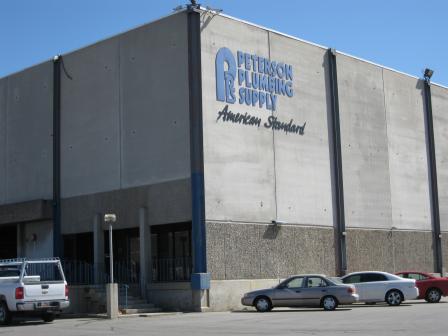 Wasatch Chemical Co. (Lot 6)The 18-acre Wasatch Chemical Co. (Lot 6) Superfund site is located in Salt Lake City, Utah. From 1957 through the early 1970s, Wasatch Chemical Company produced industrial chemicals on site. These chemicals included herbicides, pesticides and fertilizers. The company’s waste disposal practices and spills contaminated soil and groundwater. The site area sits in the center of the Jordan River Valley, over an aquifer that is a regional source of potable water. In June 1986, EPA removed drums and containers from the site. EPA added the site to the National Priorities List (NPL) in 1991. The site’s responsible party treated soil and groundwater; cleanup finished in 1997. An industrial steel warehouse, plumbing supply warehouse and office buildings operate on site. Monitoring is ongoing.
Wasatch Chemical Co. (Lot 6)The 18-acre Wasatch Chemical Co. (Lot 6) Superfund site is located in Salt Lake City, Utah. From 1957 through the early 1970s, Wasatch Chemical Company produced industrial chemicals on site. These chemicals included herbicides, pesticides and fertilizers. The company’s waste disposal practices and spills contaminated soil and groundwater. The site area sits in the center of the Jordan River Valley, over an aquifer that is a regional source of potable water. In June 1986, EPA removed drums and containers from the site. EPA added the site to the National Priorities List (NPL) in 1991. The site’s responsible party treated soil and groundwater; cleanup finished in 1997. An industrial steel warehouse, plumbing supply warehouse and office buildings operate on site. Monitoring is ongoing.
Last updated September 2019
As of December 2019, EPA had data on 3 on-site businesses. These businesses employed 46 people and generated an estimated $37,216,000 in annual sales revenue. For additional information click here.
For more information:
